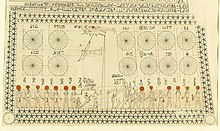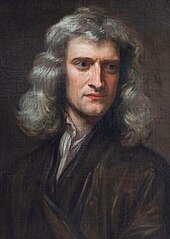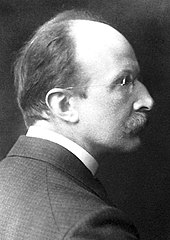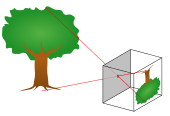HISTORY
History
The word "physics" comes from Ancient Greek: φυσική (ἐπιστήμη), romanized: physikḗ (epistḗmē), meaning "knowledge of nature".[8][9][10]
Ancient astronomy

Astronomy is one of the oldest natural sciences. Early civilizations dating back before 3000 BCE, such as the Sumerians, ancient Egyptians, and the Indus Valley Civilisation, had a predictive knowledge and a basic awareness of the motions of the Sun, Moon, and stars. The stars and planets, believed to represent gods, were often worshipped. While the explanations for the observed positions of the stars were often unscientific and lacking in evidence, these early observations laid the foundation for later astronomy, as the stars were found to traverse great circles across the sky,[6] which however did not explain the positions of the planets.
According to Asger Aaboe, the origins of Western astronomy can be found in Mesopotamia, and all Western efforts in the exact sciences are descended from late Babylonian astronomy.[11] Egyptian astronomers left monuments showing knowledge of the constellations and the motions of the celestial bodies,[12] while Greek poet Homer wrote of various celestial objects in his Iliad and Odyssey; later Greek astronomers provided names, which are still used today, for most constellations visible from the Northern Hemisphere.[13]
Natural philosophy
Natural philosophy has its origins in Greece during the Archaic period (650 BCE – 480 BCE), when pre-Socratic philosophers like Thales rejected non-naturalistic explanations for natural phenomena and proclaimed that every event had a natural cause.[14] They proposed ideas verified by reason and observation, and many of their hypotheses proved successful in experiment;[15] for example, atomism was found to be correct approximately 2000 years after it was proposed by Leucippus and his pupil Democritus.[16]
Medieval European and Islamic
The Western Roman Empire fell in the fifth century, and this resulted in a decline in intellectual pursuits in the western part of Europe. By contrast, the Eastern Roman Empire (also known as the Byzantine Empire) resisted the attacks from the barbarians, and continued to advance various fields of learning, including physics.[17]
In the sixth century, Isidore of Miletus created an important compilation of Archimedes' works that are copied in the Archimedes Palimpsest.

In sixth-century Europe John Philoponus, a Byzantine scholar, questioned Aristotle's teaching of physics and noted its flaws. He introduced the theory of impetus. Aristotle's physics was not scrutinized until Philoponus appeared; unlike Aristotle, who based his physics on verbal argument, Philoponus relied on observation. On Aristotle's physics Philoponus wrote:
But this is completely erroneous, and our view may be corroborated by actual observation more effectively than by any sort of verbal argument. For if you let fall from the same height two weights of which one is many times as heavy as the other, you will see that the ratio of the times required for the motion does not depend on the ratio of the weights, but that the difference in time is a very small one. And so, if the difference in the weights is not considerable, that is, of one is, let us say, double the other, there will be no difference, or else an imperceptible difference, in time, though the difference in weight is by no means negligible, with one body weighing twice as much as the other[19]
Philoponus' criticism of Aristotelian principles of physics served as an inspiration for Galileo Galilei ten centuries later,[20] during the Scientific Revolution. Galileo cited Philoponus substantially in his works when arguing that Aristotelian physics was flawed.[21][22] In the 1300s Jean Buridan, a teacher in the faculty of arts at the University of Paris, developed the concept of impetus. It was a step toward the modern ideas of inertia and momentum.[23]
Islamic scholarship inherited Aristotelian physics from the Greeks and during the Islamic Golden Age developed it further, especially placing emphasis on observation and a priori reasoning, developing early forms of the scientific method.
The most notable innovations were in the field of optics and vision, which came from the works of many scientists like Ibn Sahl, Al-Kindi, Ibn al-Haytham, Al-Farisi and Avicenna. The most notable work was The Book of Optics (also known as Kitāb al-Manāẓir), written by Ibn al-Haytham, in which he conclusively disproved the ancient Greek idea about vision, but also came up with a new theory. In the book, he presented a study of the phenomenon of the camera obscura (his thousand-year-old version of the pinhole camera) and delved further into the way the eye itself works. Using dissections and the knowledge of previous scholars, he was able to begin to explain how light enters the eye. He asserted that the light ray is focused, but the actual explanation of how light projected to the back of the eye had to wait until 1604. His Treatise on Light explained the camera obscura, hundreds of years before the modern development of photography.[24]
The seven-volume Book of Optics (Kitab al-Manathir) hugely influenced thinking across disciplines from the theory of visual perception to the nature of perspective in medieval art, in both the East and the West, for more than 600 years. Many later European scholars and fellow polymaths, from Robert Grosseteste and Leonardo da Vinci to René Descartes, Johannes Kepler and Isaac Newton, were in his debt. Indeed, the influence of Ibn al-Haytham's Optics ranks alongside that of Newton's work of the same title, published 700 years later.
The translation of The Book of Optics had a huge impact on Europe. From it, later European scholars were able to build devices that replicated those Ibn al-Haytham had built, and understand the way light works. From this, important inventions such as eyeglasses, magnifying glasses, telescopes, and cameras were developed.
Classical


Physics became a separate science when early modern Europeans used experimental and quantitative methods to discover what are now considered to be the laws of physics.[25][page needed]
Major developments in this period include the replacement of the geocentric model of the Solar System with the heliocentric Copernican model, the laws governing the motion of planetary bodies (determined by Kepler between 1609 and 1619), Galileo's pioneering work on telescopes and observational astronomy in the 16th and 17th Centuries, and Newton's discovery and unification of the laws of motion and universal gravitation (that would come to bear his name).[26] Newton also developed calculus,[d] the mathematical study of change, which provided new mathematical methods for solving physical problems.[27]
The discovery of new laws in thermodynamics, chemistry, and electromagnetics resulted from greater research efforts during the Industrial Revolution as energy needs increased.[28] The laws comprising classical physics remain very widely used for objects on everyday scales travelling at non-relativistic speeds, since they provide a very close approximation in such situations, and theories such as quantum mechanics and the theory of relativity simplify to their classical equivalents at such scales. However, inaccuracies in classical mechanics for very small objects and very high velocities led to the development of modern physics in the 20th century.
Modern


Modern physics began in the early 20th century with the work of Max Planck in quantum theory and Albert Einstein's theory of relativity. Both of these theories came about due to inaccuracies in classical mechanics in certain situations. Classical mechanics predicted a varying speed of light, which could not be resolved with the constant speed predicted by Maxwell's equations of electromagnetism; this discrepancy was corrected by Einstein's theory of special relativity, which replaced classical mechanics for fast-moving bodies and allowed for a constant speed of light.[29] Black-body radiation provided another problem for classical physics, which was corrected when Planck proposed that the excitation of material oscillators is possible only in discrete steps proportional to their frequency; this, along with the photoelectric effect and a complete theory predicting discrete energy levels of electron orbitals, led to the theory of quantum mechanics taking over from classical physics at very small scales.[30]
Quantum mechanics would come to be pioneered by Werner Heisenberg, Erwin Schrödinger and Paul Dirac.[30] From this early work, and work in related fields, the Standard Model of particle physics was derived.[31] Following the discovery of a particle with properties consistent with the Higgs boson at CERN in 2012,[32] all fundamental particles predicted by the standard model, and no others, appear to exist; however, physics beyond the Standard Model, with theories such as supersymmetry, is an active area of research.[33] Areas of mathematics in general are important to this field, such as the study of probabilities and groups.



Comments
Post a Comment